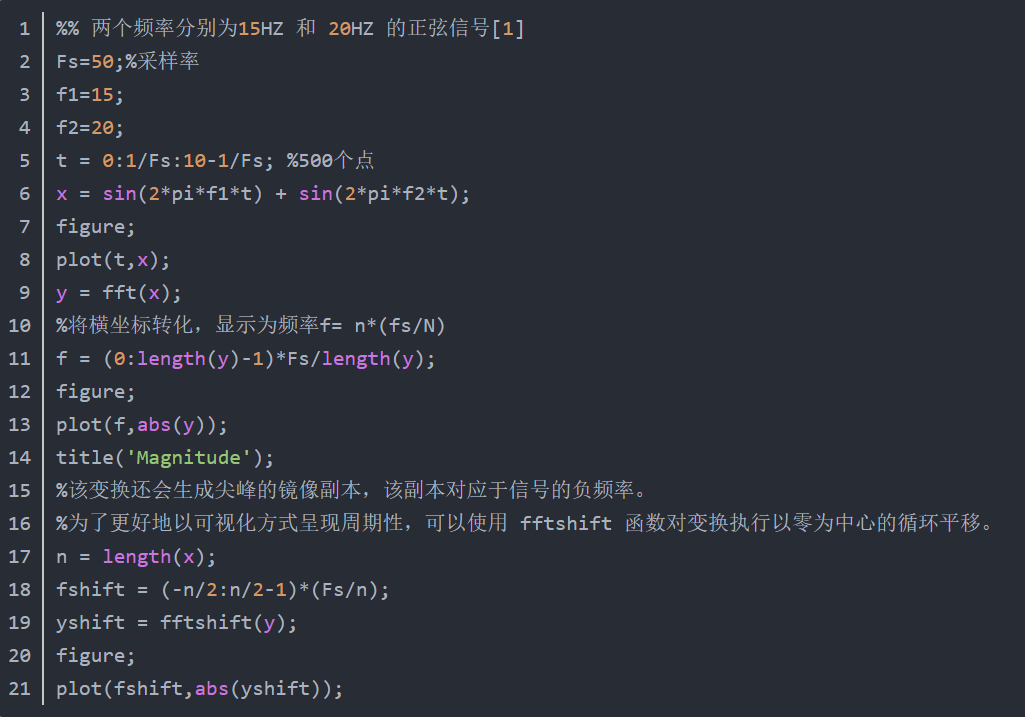clear all
clc
%% 设置原始信号
%t = -0.2 : 0.0005 : 0.2;
t = -0.2 : (1/80) : 0.2;
N = 1000;
k = -N : N;
W = k * 2000 / N;
origin = sin(2 * pi * 60 * t) + cos(2 * pi * 25 * t) + sin(2 * pi * 30 * t);% 原始信号为正弦信号叠加
origin_F = origin * exp(-1i * t' * W) * 0.0005;% 傅里叶变换
origin_F = abs(origin_F);% 取正值
figure;
subplot(4, 2, 1); plot(t, origin); title('原信号时域');
subplot(4, 2, 2); plot(W, origin_F); title('原信号频域');
%fs = 1/0.0005;
fs = 80 ;
f = (-N:N-1)*(fs)/(2*N);
figure;
plot(f,abs(fftshift(fft(origin,2*N))));
%% 对原始信号进行80Hz采样率采样
Nsampling = 1/80; % 采样频率
t = -0.2 : Nsampling : 0.2;
f_80Hz = sin(2 * pi * 60 * t) + cos(2 * pi * 25 * t) + sin(2 * pi * 30 * t); %采样后的信号
F_80Hz = f_80Hz * exp(-1i * t' * W) * Nsampling; % 采样后的傅里叶变换
F_80Hz = abs(F_80Hz);
subplot(4, 2, 3); stem(t, f_80Hz); title('80Hz采样信号时域');
subplot(4, 2, 4); plot(W, F_80Hz); title('80Hz采样信号频域');
%% 对原始信号进行121Hz采样率采样
Nsampling = 1/121; % 采样频率
t = -0.2 : Nsampling : 0.2;
f_80Hz = sin(2 * pi * 60 * t) + cos(2 * pi * 25 * t) + sin(2 * pi * 30 * t); %采样后的信号
F_80Hz = f_80Hz * exp(-1i * t' * W) * Nsampling; % 采样后的傅里叶变换
F_80Hz = abs(F_80Hz);
subplot(4, 2, 5); stem(t, f_80Hz); title('121Hz采样信号时域');
subplot(4, 2, 6); plot(W, F_80Hz); title('121Hz采样信号频域');
%% 对原始信号进行150Hz采样率采样
Nsampling = 1/150; % 采样频率
t = -0.2 : Nsampling : 0.2;
f_80Hz = sin(2 * pi * 60 * t) + cos(2 * pi * 25 * t) + sin(2 * pi * 30 * t); %采样后的信号
F_80Hz = f_80Hz * exp(-1i * t' * W) * Nsampling; % 采样后的傅里叶变换
F_80Hz = abs(F_80Hz);
subplot(4, 2, 7); stem(t, f_80Hz); title('150Hz采样信号时域');
subplot(4, 2, 8); plot(W, F_80Hz); title('150Hz采样信号频域');
%% 恢复原始信号
% 从80Hz采样信号恢复
figure;
n = -100 : 100;
Nsampling = 1/80;
n_sam = n * Nsampling;
f_uncovery = sin(2 * pi * 60 * n_sam) + cos(2 * pi * 25 * n_sam) + sin(2 * pi * 30 * n_sam);
t = -0.2 : 0.0005 : 0.2;
f_covery = f_uncovery * sinc((1/Nsampling) * (ones(length(n_sam), 1) * t - n_sam' * ones(1, length(t))));
subplot(3, 1, 1); plot(t, f_covery); title('80Hz信号恢复');
% 从121Hz采样信号恢复
Nsampling = 1/121;
n_sam = n * Nsampling;
f_uncovery = sin(2 * pi * 60 * n_sam) + cos(2 * pi * 25 * n_sam) + sin(2 * pi * 30 * n_sam);
t = -0.2 : 0.0005 : 0.2;
f_covery = f_uncovery * sinc((1/Nsampling) * (ones(length(n_sam), 1) * t - n_sam' * ones(1, length(t))));
subplot(3, 1, 2); plot(t, f_covery); title('121Hz信号恢复');
% 从150Hz采样信号恢复
Nsampling = 1/150;
n_sam = n * Nsampling;
f_uncovery = sin(2 * pi * 60 * n_sam) + cos(2 * pi * 25 * n_sam) + sin(2 * pi * 30 * n_sam);
t = -0.2 : 0.0005 : 0.2;
f_covery = f_uncovery * sinc((1/Nsampling) * (ones(length(n_sam), 1) * t - n_sam' * ones(1, length(t))));
subplot(3, 1, 3); plot(t, f_covery); title('150Hz信号恢复');






